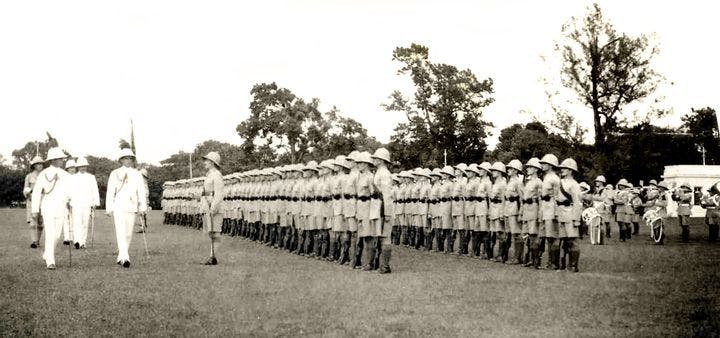Fall 2013
Theater of Victory
– The Wilson Quarterly
To convince the world you’ve prevailed in battle, sometimes you have to get creative.
In the mid-1860s, Emperor Tewodros of Ethiopia found his kingdom in revolt. He petitioned Britain for military aid. Britain ignored him. Hoping to seize the larger empire’s attention, Tewodros imprisoned a handful of British government consuls and missionaries. He got a bigger response than he bargained for.
Thirteen thousand soldiers joined what became known as the expedition to Abyssinia (as Ethiopia was then known), war correspondent and popular historian Alan Moorehead wrote in The Blue Nile (1962). Also deployed were 19,000 support staff and 55,000 animals, including 44 Indian elephants trained to pull cannon. The shipment of one cohort of the giant beasts got off to an auspicious start: “The animals were slung on board without mishap at Bombay. ... They stood back to back with their heads toward the sides, and a corridor between them to allow the attendants to pass to and fro.” But things did not go so well for the pachyderms that embarked from another port on the Indian coast: “A seasick elephant was a formidable thing, and in the Calcutta moorings they had to face a cyclone.”
The expensive expedition was one of many during Queen Victoria’s reign, from 1837 to 1901, in which not a year passed that didn’t see British troops engaged in battle. Yet the nature of warfare was changing. The campaigns among subject peoples often failed to produce conclusive results. At the same time, a growing throng of journalists connected by the recently invented telegraph put Victoria’s wars almost in the parlors of Britons. And popular support was increasingly essential. In The Journal of Military History, Bruce Collins, professor of modern history at Sheffield Hallam, a university in England, considers how commanders defined victories — and communicated them to their fellow Britons — in a series of wars fought in theaters around the globe, not only Ethiopia but Crimea, India, China, Afghanistan, Egypt, and Zululand, among others.
Journalists embedded with military expeditions, dispatching their stories via the new telegraphs, intensified the pressure to deliver speedy, clear-cut victories that emphasized British daring. Far-flung commanders also felt the heat as Britain began to prioritize self-defense back home. Finally, British commanders fighting in small wars sweated to measure up to military achievements in India that, to the Victorian mind, served as proof of Anglo-Saxon supremacy over inferior races.
At times, exotic theaters of war flummoxed commanders and politicians hoping for battlefield glory. “Most of Britain’s opponents did not anchor their defensive strategies upon battle,” Collins writes. “For peoples or regimes which saw retreating, regrouping, and surviving as a legitimate strategy, or for whom ‘warfare’ consisted of seasonal raiding, the impatient, timetabled approach of British commanders seemed both alien and inappropriate.” Joining French forces to march on Peking in 1860, for instance, the British found themselves in a wild-goose chase after a retreating enemy.
Franco-British forces would settle for a looting of the emperor’s summer palace and a “choreographed military display” once a treaty with the Chinese was finally secured. It would have to do. “The presence of a large body of troops marching with confidence through the capital, with colors flying, bands playing, and every outward sign of victory, must have, indeed, impressed all with the reality of their own defeat,” Field Marshal Garnet Wolseley decided.
Journalists — some of whom were handpicked by the military — amplified the propaganda in their reportage, though opportunities existed to report inglorious aspects of war at every turn. Collins notes that an officer witnessing a victory march through Cairo groused that “the length of the triumphal processions owed more to the narrowness of the streets than to the grandeur of the occasion. ... Another contrasted impressive claims to victory with the grim reality of a British army encampment” where diarrhea was epidemic.
The press evidently preferred in most cases to go along with commanders’ assessments: The number of a given people subdued by the British would be inflated, as would be their compliance, and civilian suffering downplayed. An editor at The Times of London, John Delane, decried Wolseley’s peacocking. But such dissent was rare, and politicians and theologians shared in journalists’ backslapping.
The peoples at the receiving end of conquest were often less than awed by the British imperial displays. Staged ceremonies failed to impress hardened Afghan fighters in Kabul in 1879, during the second invasion of Afghanistan. (The first invasion had ended in disaster, with only one of 16,000 retreating British troops and support personnel surviving.) In one instance, to give the appearance of a victory, a British military tribunal had 76 Afghans summarily hanged, and ordered swaths of outlying villages burned.
Embarrassed by some press criticism of the attack — pains had been taken to install a sympathetic press corps in Kabul — and with winter approaching, commanders were eager to get troops out of the city. A ruffled Duke of Cambridge wrote to one commander, “I for my part should gladly see us well out of Cabul and yet how to accomplish this shift of policy without losing prestige amongst the Native populations not only of Afghanistan, but throughout India?”
THE SOURCE: “Defining Victory in Victorian Warfare” by Bruce Collins. The Journal of Military History, July 2013.
Photo courtesy of Wikimedia Commons
